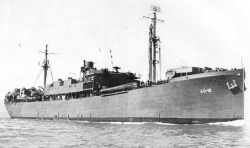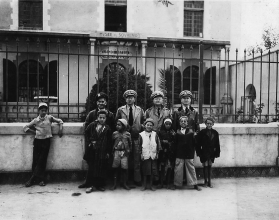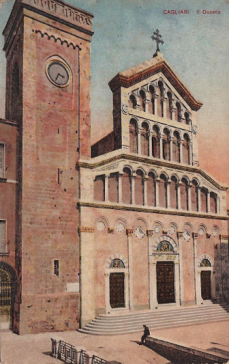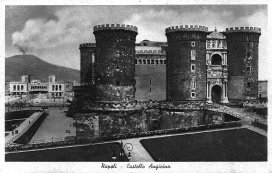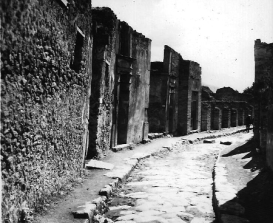THE DENEBOLA CROSSES THE ATLANTIC, 1944
Travels and Sightseeing in the Mediterranean
Recollections of Milton W. Sherman
By Stephen Sherman, April, 2010. Updated February 16, 2012.
The Destroyer Tender Denebola spent a couple of years of WWII on a few short assignments that included involvement in the transfer of the overage destroyers to Great Britain (1940), its first notable activity in the war in Europe. During those years the U.S. Navy was expanding and in the course of this expansion a naval base and fleet anchorage was established in Casco Bay, Portland, Maine.
The naval base and anchorage became the home base of the North Atlantic Destroyer squadrons after the entrance of the United States into WW-II. (1942). The Denebola was designated the tender for the destroyers and became a fixture in Casco Bay until April, 1944. At this time and after extensive refitting in South Boston naval dry-dock, the "Denny" began its two years of intermittent travel, starting with its cruise to the Mediterranean
Preparations - Spring, 1944
When many of us first set foot on the Denny there were feelings of apprehension combined with uncertainty. Those were the pervasive feelings nearly all of us felt until the war was over. It eased a bit after being aboard for awhile.
To seek solace we sometimes struck up a conversation with a shipmate-stranger. So it was one April morning, 1944. Among other things the question was broached, "Does this ship ever go anywhere?" Go anywhere? the man repeated, "This tub can't go anywhere, she's stuck on a mountain of coffee grounds." An old saw by then, but on hearing for the first time it sounded hilarious.
Before April was over the fallacy of the gag became quite apparent. Activity set in, lots of it, accompanied by much bellowing, directing, and arm swinging, Things were going off the ship and things were coming on. The rumors took off! It was plain that this was not to be just another trip to Boston to get the bottom scraped. We were going ... but where? That was a secret. A leak developed though. Some of the material coming aboard was plainly destined for Hilary P. Jones, DD-427. The secret was out. A man on the Denny had a buddy serving on the H.P. Jones and that buddy found a way to let his pal on the Denny know that the Jones was operating in the Mediterranean. Simple enough, huh?. But that doesn't mean that the news was peddled up and down the waterfront. It's safe to say that the information stayed aboard ship.
After a refreshing month or so in that oasis of rest relaxation and pleasure, the South Boston Naval dry dock, the mighty Denebola was refloated and shoved out into the harbor.
She was ready to go!
After a safe passage along the coast we eased into Hampton Roads and Norfolk. Norfolk at that time was the city of unprintable nicknames. We were not there very long, an undisguised blessing to be sure.
Crossing the Atlantic
When we left, we stood out to sea for what turned out to be something of a pleasure cruise. At least the first half was that way. The wild and stormy Atlantic was in a good mood for many of the days of the crossing. About all that ruffled the surface the unusually calm sea was the playful cavorting of porpoises, always tagging along close to the ship.
On another occasion, and while the sea was still calm, there appeared near the ship what looked like a couple of huge sea creatures. Nobody knew what they were. Whales were ruled out because they were a sort of tan color and were not spouting. This mystery led J.B. Sidley of the eighth division to quip that it was only the CPOs, Rapp and Eckmann out for a dip.
There was something else interesting to observe in the behavior of the sea, and that was the swells. Always the surface of the ocean was undulating no matter how calm and smooth it was. We had only a few more days until we expected to raise the strait of Gibraltar. But several days before, the ocean changed its mood. While it did not become stormy,it became extremely rough and windy. The "flung spray and the blown spume" were very much in evidence. For some it was a time of seasickness. For others it was a time for making and eating french fried potatoes in the repair machine shops. This made the sick boys sicker. Cooking oil and cutting oil aromas made a bad combination.
Soon the heavy weather abated, so it became a pleasure cruise again but not for all.
The Rock of Gibraltar
When we reached Gibraltar luck was with us. We were there in broad daylight. That was a break, since it allowed us a fine view of the rock. The day was hazy so not a lot of detail was discernible. It seemed however, much larger and loftier than we had expected.
The long sloping rain gathering devices that are essential for the water supply for the inhabitants of the Rock were clearly visible. Since we did not come as close to the Rock as we had anticipated we could not see much detail. About the only sign of human activity were a couple of planes that because of haze and distance, seemed to be drifting along quite lazily.
Algeria
As the Rock of Gibraltar disappeared, it became known that our next stop would be at Mers El Kebir (MEK) and Oran in Algeria.
MEK was a small, port west of Oran with a mile long jetty that formed a splendid harbor. There was the U.S.S. Vulcan, AR-5, which had been there for eighteen months. When her crew spotted AD-12, their hopes rose that we were there to relieve them. But it wasn't so; we sailed off after a couple of nights.
After spending one night in the harbor of MEK, and before breakfast, a buddy said to me with some excitement, "Hey, get up on deck and take a look around." An amazing change had taken place during the night. The harbor was full of ships, part of the build-up of forces for the invasion of southern France. During our second night there, the invasion force, just as mysteriously, slipped away.
We were not far behind them, having gotten underway ourselves shortly after they had left.
See more pictures of Algeria.
Cagliari, Sardinia
Our next port of call was Cagliari, Sardinia. Here the language is Italian so "Boats" Doherty was once again the cock-of-the-walk. They broke him out to be official interpreter because spoke the lingo.
Cagliari was perhaps the most pathetic of all the places at which we called. Pathetic because, even to us the place was not militarily significant. The trouble was that the Germans were, or had been using it as a transfer area for supplies. For that reason nearly one hundred American bombers came over some months before we were there and in their effort to bomb the waterfront and harbor, for the most part missed both and rained bombs on the city. Thus it was that the city was covered with a fine white (plaster) dust.
Cagliari's citizens were obviously tired and weary of it all, and yet seemed to bear no ill-will to the Americans.
It was here that we had our first exposure to the street urchins of Europe; Italy in particular. These kids would fight each other tooth and nail for the Hershey bars that we threw off the ship. Often they would tear the candy to pieces until there was nothing left of it. They seemed to prize most highly, the Hershey bars and any form of soap. To look at them was to understand why.
See more pictures of Cagliari.
Ajaccio, Corsica
Next was Ajaccio, Corsica, birthplace of Napoleon, and that was the only thing it had going for it. Unless one counts the bold and mangy rats that could be seen most any time scurrying along the gutter, darting in and out of alleys.
Toulon, The French Riviera
We left Corsica and headed north. We tended to overlook the fact that this region had undergone four years of war.
We stopped at only three places; Toulon, St.Tropez, and St. Maxime. One after another those names sparked our imagination. As we moved from place to place we began to realize that these people and these places were worn down and nearly out. They had had it!
See more pictures of Toulon.
Naples and Pompeii, Italy
Naples is where we stayed for the longest time, five or six weeks. Some of our memories of Naples include:
- The crowds of people coming and going along Via Roma. The variety of military uniforms from all over the world, to be seen on Via Roma, the main street of Naples.
- The sight of Mt. Vesuvius with its ever-present wisp of smoke, across the bay of Naples.
- The finding of the crates full of U.S.Navy Recognition Manuals (restricted) in one of the caves in the jetty.
- Being suddenly startled by the sight of an apparently dead kid in another of the jetty's caves. He was only asleep, probably no home, no parents, no food, no anything.
- The sight of a small boy being knocked over by a fast backing U.S. jeep in the Palazzo di Citta. The jeep roared off and the excited and squabbling friends of the kid hauled him away.
- Arriving by jeep in an outlying part of the city where we entered a large square that was dominated by a huge sign proclaiming "dangerous type of VD in this area."
- The ride to Pozzuoli, Sophia Loren's hometown; where she was a starving kid at that time, on another "Toonerville Trolley."
- The trip to Pompeii on the Toonerville trolley-like railroad. When coming to a station, the motormen would poke his head out of the window, place a cow horn to his lips and blow a tin-horn sounding shriek to warn the swarm of people that were spilling over and onto the tracks.
- The never ending chant of the kids, "Hey Joe, y'wanna eat? y'wanna drink? y'wanna dance Joe"? and in a lowered voice, "Hey Joe, ya wanna eat spaghetti, Joe?"
- The kids again this time back to the jetty. They were using a long handled net with one flat side on the rim. They were scraping this along the side of the jetty and bringing up from the indescribably filthy water small wriggling, black creatures that we took to be live bait. In response to our sign language inquiry as to their use, one kid promptly bit one in half and chewed it up, while our stomachs looped.
See more pictures of Pompeii.
See more pictures of Naples.
The Pacific
In 1945, the Denebola sailed to the Pacific.Read about and see pictures of Hawaii.
Read about and see pictures of Eniwetok.
Sources:
Memoirs and photographs of Milton W. Sherman (1919-2010). He served in the U.S. Navy during WW2, on board the USS Denebola, AD-12, when he was in mid-twenties. On board the Denebola, he sailed to the Mediterranean in late 1944, where he bought these vintage postcards from street vendors and the photos from the ship's photographer.

